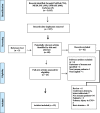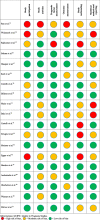The prognostic value of serum procalcitonin measurements in critically injured patients: a systematic review
- PMID: 31796098
- PMCID: PMC6892215
- DOI: 10.1186/s13054-019-2669-1
The prognostic value of serum procalcitonin measurements in critically injured patients: a systematic review
Abstract
Background: Major trauma is associated with high incidence of septic complications and multiple organ dysfunction (MOD), which markedly influence the outcome of injured patients. Early identification of patients at risk of developing posttraumatic complications is crucial to provide early treatment and improve outcomes. We sought to evaluate the prognostic value of serum procalcitonin (PCT) levels after trauma as related to severity of injury, sepsis, organ dysfunction, and mortality.
Methods: We searched PubMed, MEDLINE, EMBASE, the Cochrane Database, and references of included articles. Two investigators independently identified eligible studies and extracted data. We included original studies that assessed the prognostic value of serum PCT levels in predicting severity of injury, sepsis, organ dysfunction, and mortality among critically injured adult patients.
Results: Among 2015 citations, 19 studies (17 prospective; 2 retrospective) met inclusion criteria. Methodological quality of included studies was moderate. All studies showed a strong correlation between initial PCT levels and Injury Severity Score (ISS). Twelve out of 16 studies demonstrated significant elevation of initial PCT levels in patients who later developed sepsis after trauma. PCT level appeared a strong predictor of MOD in seven out of nine studies. While two studies did not show association between PCT levels and mortality, four studies demonstrated significant elevation of PCT levels in non-survivors versus survivors. One study reported that the PCT level of ≥ 5 ng/mL was associated with significantly increased mortality (OR 3.65; 95% CI 1.03-12.9; p = 0.04).
Conclusion: PCT appears promising as a surrogate biomarker for trauma. Initial peak PCT level may be used as an early predictor of sepsis, MOD, and mortality in trauma population.
Keywords: Critical care; Injuries; Intensive care unit; Procalcitonin; Prognosis; Trauma.
Conflict of interest statement
AWK has received funding from Kinetic Concepts Incorporated for a randomized controlled trial comparing the ABThera™ Open Abdomen Negative Pressure Therapy system and Barker’s vacuum pack temporary abdominal closure techniques. He has also received travel funding from LifeCell Corp., Syntheses, and Innovative Trauma Care. The other authors declare that they have no competing interests.
Figures
Dataset use reported in
-
Procalcitonin to allow early detection of sepsis and multiple organ failure in severe multiple trauma: beware of some confounders.Crit Care. 2020 Jan 7;24(1):9. doi: 10.1186/s13054-020-2729-6. Crit Care. 2020. PMID: 31910884 Free PMC article. No abstract available.
Similar articles
-
[The prognostic value of serum procalcitonin on severity of illness in non-sepsis critically ill patients].Zhonghua Wei Zhong Bing Ji Jiu Yi Xue. 2016 Aug;28(8):688-93. doi: 10.3760/cma.j.issn.2095-4352.2016.08.004. Zhonghua Wei Zhong Bing Ji Jiu Yi Xue. 2016. PMID: 27434557 Chinese.
-
Relationship between procalcitonin plasma levels and severity of injury, sepsis, organ failure, and mortality in injured patients.Crit Care Med. 2000 Apr;28(4):950-7. doi: 10.1097/00003246-200004000-00007. Crit Care Med. 2000. PMID: 10809265
-
Procalcitonin as a prognostic and diagnostic tool for septic complications after major trauma.Crit Care Med. 2009 Jun;37(6):1845-9. doi: 10.1097/CCM.0b013e31819ffd5b. Crit Care Med. 2009. PMID: 19384224
-
The Advancement in Detecting Sepsis and Its Outcome: Usefulness of Procalcitonin in Diagnosing Sepsis and Predicting Fatal Outcomes in Patients Admitted to Intensive Care Unit.Cureus. 2021 Apr 12;13(4):e14439. doi: 10.7759/cureus.14439. Cureus. 2021. PMID: 33996303 Free PMC article. Review.
-
The efficacy of procalcitonin as a biomarker in the management of sepsis: slaying dragons or tilting at windmills?Surg Infect (Larchmt). 2013 Dec;14(6):489-511. doi: 10.1089/sur.2012.028. Epub 2013 Nov 25. Surg Infect (Larchmt). 2013. PMID: 24274059 Review.
Cited by
-
Early changes in white blood cell, C-reactive protein and procalcitonin levels in children with severe multiple trauma.World J Emerg Med. 2022;13(6):448-452. doi: 10.5847/wjem.j.1920-8642.2022.093. World J Emerg Med. 2022. PMID: 36636564 Free PMC article.
-
Serum Mrp 8/14 as a Potential Biomarker for Predicting the Occurrence of Acute Respiratory Distress Syndrome Induced by Sepsis: A Retrospective Controlled Study.J Inflamm Res. 2024 May 13;17:2939-2949. doi: 10.2147/JIR.S457547. eCollection 2024. J Inflamm Res. 2024. PMID: 38764498 Free PMC article.
-
Accuracy of Procalcitonin Levels for Diagnosis of Culture-Positive Sepsis in Critically Ill Trauma Patients: A Retrospective Analysis.Cureus. 2021 Jan 29;13(1):e12988. doi: 10.7759/cureus.12988. Cureus. 2021. PMID: 33659123 Free PMC article.
-
A Pilot Study Assessing the Utility of Quantitative Myeloid-Derived Suppressor Cell Measurements in Detecting Posttraumatic Infection.Crit Care Explor. 2025 Mar 17;7(3):e1228. doi: 10.1097/CCE.0000000000001228. eCollection 2025 Mar 1. Crit Care Explor. 2025. PMID: 40100961 Free PMC article.
-
Hepatocellular Damage and Severity of COVID-19 Infection in Iraqi Patients: A Biochemical Study.Rep Biochem Mol Biol. 2022 Oct;11(3):524-531. doi: 10.52547/rbmb.11.3.524. Rep Biochem Mol Biol. 2022. PMID: 36718303 Free PMC article.
References
-
- Centers for Disease Control and Prevention, National Center for Injury Prevention and Control. Web–based Injury Statistics Query and Reporting System (WISQARS) [online] [2014] Available from URL: https://www.cdc.gov/injury/wisqars/.
-
- Trunkey DD. Trauma. Accidental and intentional injuries account for more years of life lost in the U.S. than cancer and heart disease. Among the prescribed remedies are improved preventive efforts, speedier surgery and further research. Sci Am. 1983;249(2):28–35. doi: 10.1038/scientificamerican0883-28. - DOI - PubMed
Publication types
MeSH terms
Substances
LinkOut - more resources
Full Text Sources
Medical
Miscellaneous




